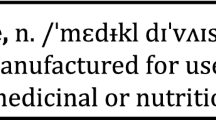Abstract
Restrictions on the use of pharmaceuticals (such as those for low molecular weight heparins) are commonly imposed by healthcare organizations to combat rising health care costs. These restrictions can be system-based which are established by imposing specific coverage policies by insurance companies and payors or can be patient-based which are those that limit certain therapeutic agents to specified patient populations.
Disease management (DM) programs are implemented by healthcare organizations to improve patient care while utilizing resources efficiently. From a payor perspective, restricted use of pharmaceuticals would conform to the goals of DM. However, from a practitioner’s perspective, restrictions on the use of medications could sometimes be viewed as conflicting with their goal of providing appropriate patient care. Formularies and prior-authorization programs may sometimes impede physicians’ clinical autonomy and may hinder physicians’ willingness to participate in DM protocols with such drug restrictions. Furthermore, direct-to-patient advertisements and patient education are encouraging patients to participate actively in the drug selection process. When pharmaceutical restrictions prevent patients from receiving their drug of choice, patients may perceive that their treatment is suboptimal and unfavorable.
Despite implementing a fine disease management protocol, imposing rigid drug-use restrictions could hinder physicians’ and patients’ buy-in of DM programs.

Similar content being viewed by others
References
Dubois RW, Chawla AJ, Neslusan CA, et al. Explaining drug spending trends: does perception match reality? Health Aff 2000; 19(2): 231–9
Iglehart J. The American health care system-expenditures: health policy report. N Engl J Med 1999; 340(1): 70–6
Levit K, Cowan C, Lazenby H, et al. Health spending in 1998: signals of change. Health Affairs 2000 Jan/Feb; 19(1): 124–32
Smith S, Heffler S, Freeland M. The next decade of health spending: a new outlook. Health Aff 1999; 18(4): 86–95
Ginsberg BH, Tan MH, Mazze R, et al. Staged diabetes management: computerizing a disease state management program. J Med Syst 1998; 22(2): 77–87
Gerber J. Implementing quality assurance programs in multigroup practices for treating hypercholesterolemia in patients with coronary artery disease. Am J Cardiol 1997; 80(8B): 57H–61H
Israel DA, McCabe M. Using disease-state management as the key tp promoting key employer sponsorship of medical nutrition therapy. J Am Diet Assoc 1999; 99(5): 583–8
Navarro RP, Christensen D, Leider H. Disease management programs in managed care pharmacy practice. Gaithersburg (MD): Aspen Publication, 1999: 372
Goldwire MA, Gurwitch KD. Modifying physician behavior in a large pediatric institution. ASHP Midyear Clinical Meeting; 1998 Dec 6–10: Las Vegas (NV): American Society of Health-System Pharmacists, 1998; 33: MCS-34
Cromwell DM, Bass EB, Steinberg EP, et al. Can restrictions on reimbursement for anti-ulcer drugs decrease Medicaid pharmacy costs without increasing hospitalizations. Health Serv Res 1999; 33(6): 1593–610
Smalley WE, Griffin MR, Fought RL, et al. Effect of a priorauthorization requirement on the use of nonsteroidal antiinflammatory drugs by Medicaid patients. N Engl J Med 1995; 332(24): 1612–7
Jones DL, Kroenke K, Landry FJ, et al. Cost savings using a stepped-care prescribing protocol for nonsteroidal antiinflammatory drugs. JAMA 1996; 275:(12) 926–30
Soumerai SB, Ross-Degnan D, Avorn J, et al. Effects of Medicaid drug payment limits on admission to hospitals and nursing homes. N Engl J Med 1991 Oct 10; 325 1072–7
Moore WJ, Newman RJ. US Medicaid drug formularies. Do they work? Pharmacoeconomics 1992; 1 Suppl. 1: 28–31
Gold MR, Hurley R, Lake T, et al. A national survey of the arrangements managed-care plans make with physicians. N Engl J Med 1995; 333: 1678–83
Hanchak NA, Schlackman N, Harmon-Weiss S. US healthcare’s quality-based compensation model. Health Care Financ Rev 1996; 3: 143–59
Schlesinger MJ, Gray BH, Perreira KM. Medical professionalism under managed care: the pros and cons of utilization review. Health Aff (Millwood) 1997; 16: 106–24
Berger JT, Rosner F. The ethics of practice guidelines. Arch Intern Med 1996; 156: 2051–6
Gray JAM. Doing the right things right. In: Evidence-based health care: how to make health policy and management decision. New York: Church Livingstone, 1997; 17–27
Tootelian DH, Gaedeke RM. An examination of physician use of and attitudes toward closed formulary drug programs. Health Mark Q 1991; 8(3–4): 193–207
Rector TS. Exhaustion of drug benefits and disenrollment of medicare beneficiaries from managed care organizations. JAMA 2000; 283(16): 2163–7
Climo MW, Israel DS, Wong ES, et al. Hospital-wide restriction of Clindamycin: effect on the incidence of Clostridium, difficile — associated diarrhea and cost. Ann Intern Med 1998; 128(12): 989–95
Huber SL, Patry RA, Hudson HD. Influencing drug use through prescription restrictions. Am J Hosp Pharm 1982; 39(11): 1898–901
Hull RD, Raskob GE, Pineo GF, et al. Subcutaneous low-molecular-weight heparin compared with continuous intravenous heparin in the treatment of proximal-vein thrombosis. N Engl J Med 1992; 326: 975–82
Koopman MM, Prandoni P, Piovella F, et al. Treatment of venous thrombosis with intravenous unfractionated heparin administered in the hospital as compared with subcutaneous low-molecular-weight heparin administered at home. The Tasman Study Group. N Engl J Med 1996; 334: 682–7
Levine M, Gent M, Hirsh J, et al. A comparison of low-molecular-weight heparin administered primarily at home with unfractionated heparin administered in the hospital for proximal deep-vein thrombosis. N Engl J Med 1996; 334: 677–81
Low-molecular-weight heparin in the treatment of patients with venous thromboembolism. The Columbus Investigators. N Engl J Med 1997; 337: 657–62
Bick RL. Low molecular weight heparins in the outpatient management of venous thromboembolism. Semin Thromb Hemost 1999; 25 Suppl. 3: 97–9
Author information
Authors and Affiliations
Corresponding author
Rights and permissions
About this article
Cite this article
Mullins, C.D., Thomas, S.K. & Roffman, D.S. Pharmaceutical Restrictions. Dis-Manage-Health-Outcomes 9, 69–74 (2001). https://doi.org/10.2165/00115677-200109020-00001
Published:
Issue Date:
DOI: https://doi.org/10.2165/00115677-200109020-00001




